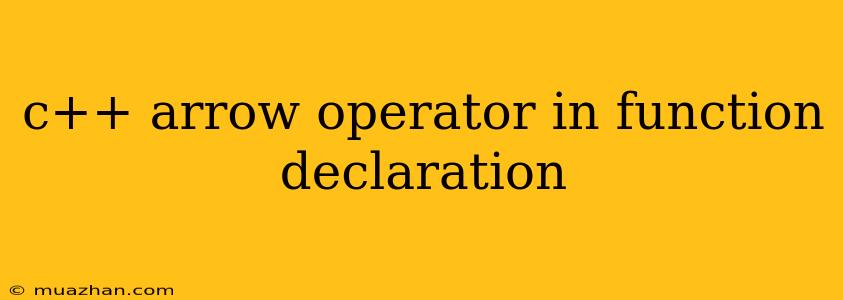C++ Arrow Operator in Function Declaration
The arrow operator (->) is a crucial component of C++ programming, particularly when working with pointers to objects. While its primary function is to access members of a structure or class through a pointer, it can also be incorporated into function declarations to handle object pointers effectively. This article will delve into the intricacies of using the arrow operator within function declarations in C++.
Understanding the Arrow Operator
At its core, the arrow operator acts as a shortcut for dereferencing a pointer and accessing a member variable or function. Consider the following example:
struct MyStruct {
int data;
};
int main() {
MyStruct myStruct = { 5 };
MyStruct *myStructPtr = &myStruct;
// Using the arrow operator:
myStructPtr->data = 10; // Equivalent to (*myStructPtr).data = 10;
return 0;
}
In this code, myStructPtr points to the myStruct object. The line myStructPtr->data = 10; uses the arrow operator to modify the data member of the structure pointed to by myStructPtr. Effectively, it dereferences the pointer and accesses the member, simplifying the process.
Arrow Operator in Function Declarations
When declaring a function that operates on objects through pointers, the arrow operator becomes essential for accessing the object's members. This is especially relevant for functions that modify or retrieve data associated with the object.
Let's examine a function that modifies a member variable of an object pointed to by a pointer:
#include
struct MyStruct {
int data;
};
void modifyData(MyStruct *objPtr, int newValue) {
objPtr->data = newValue;
}
int main() {
MyStruct myStruct = { 5 };
MyStruct *myStructPtr = &myStruct;
modifyData(myStructPtr, 10); // Pass the object pointer to the function
std::cout << "Modified data: " << myStructPtr->data << std::endl; // Output: Modified data: 10
return 0;
}
In this scenario, the modifyData function takes a pointer to a MyStruct object and a new value as parameters. The arrow operator is used within the function to access the data member of the object pointed to by objPtr. This allows the function to modify the object's internal state.
Key Considerations
- Clarity and Conciseness: The arrow operator provides a more readable and concise way to handle pointers and object members compared to explicit dereferencing.
- Function Parameters: When functions operate on objects through pointers, the arrow operator is often necessary to access the object's members.
- Data Modification: Functions using the arrow operator within their declarations can effectively modify the state of the object pointed to by the pointer.
Conclusion
The arrow operator is a powerful tool in C++ when working with pointers to objects. Its inclusion in function declarations allows for seamless interaction with object members, enabling functions to modify, access, and manipulate the data associated with objects pointed to by pointers. By understanding its function and incorporating it appropriately, developers can write clean, efficient, and maintainable C++ code.
